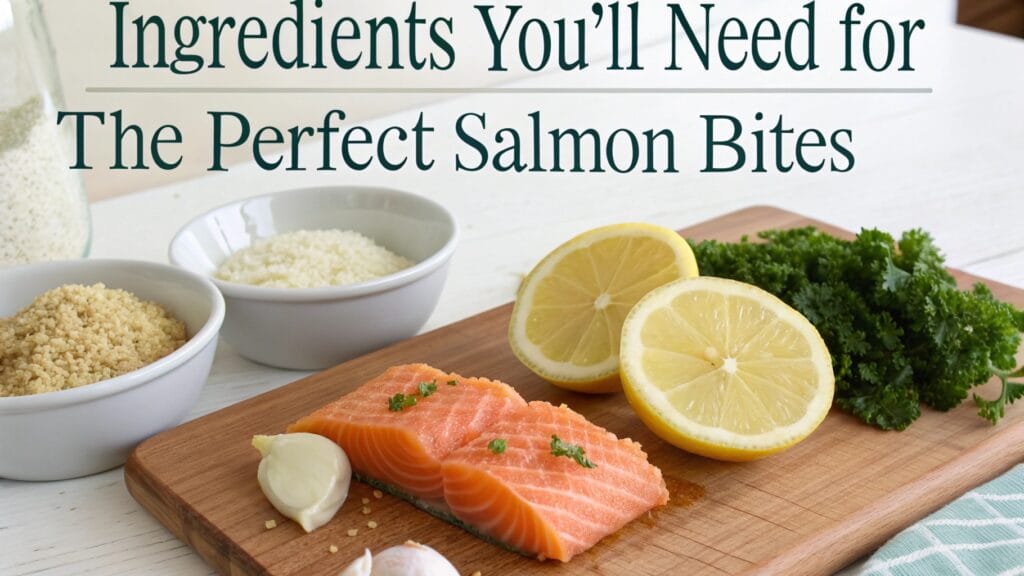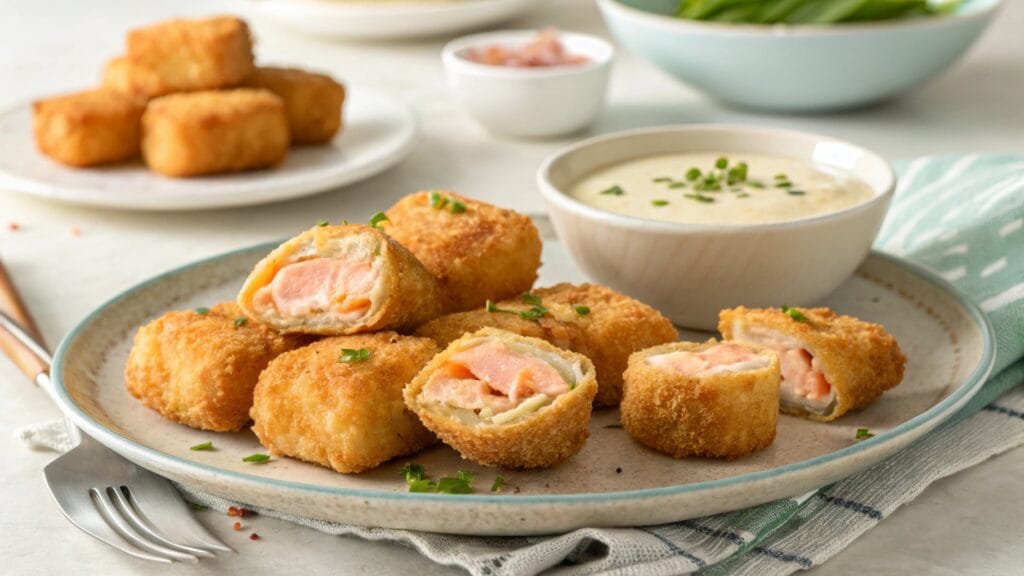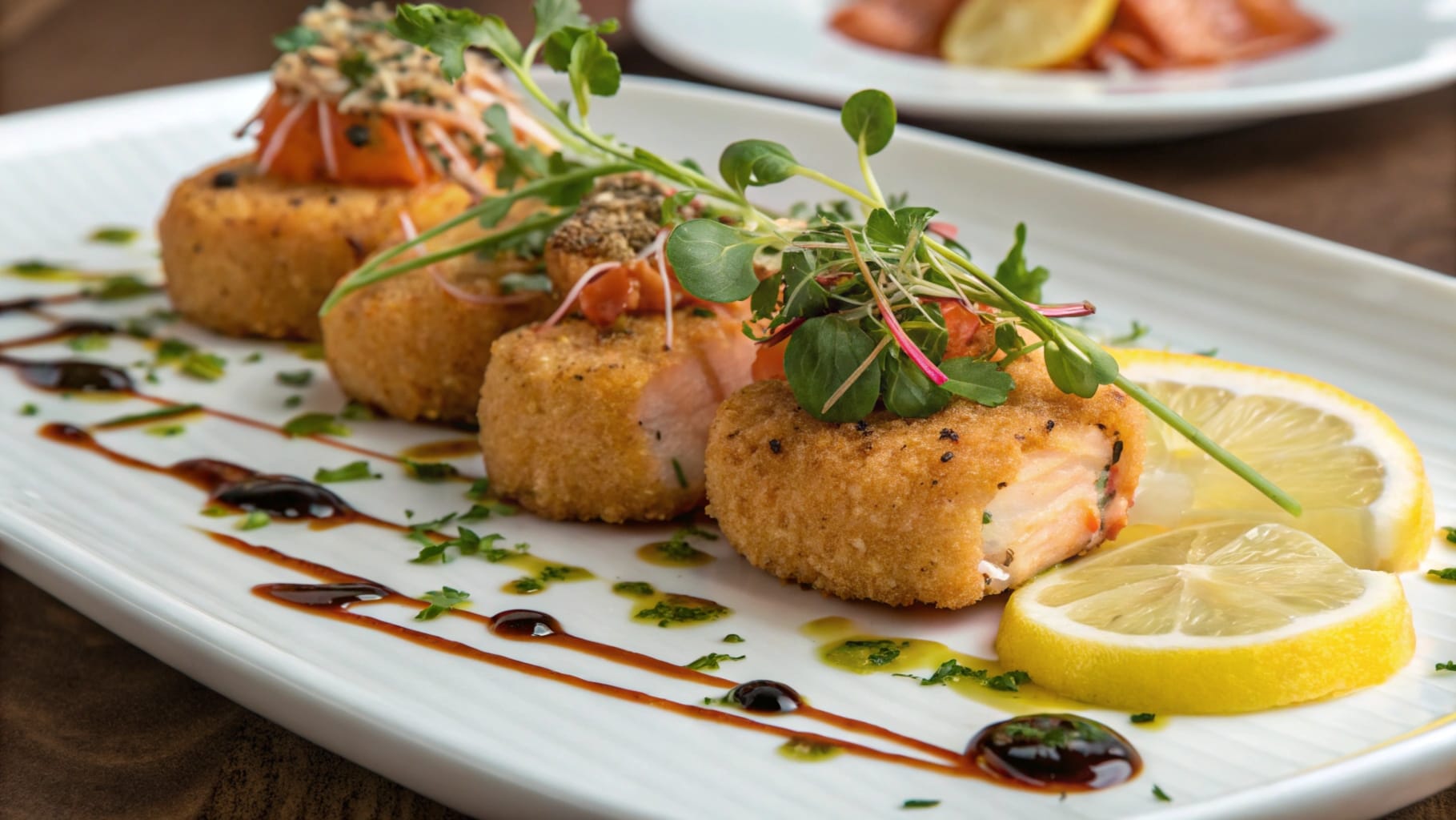Salmon bites are the perfect blend of flavor, texture, and health benefits. Whether you’re looking for a tasty appetizer, a protein-packed snack, or a light main course, this easy-to-make recipe is sure to become a go-to in your kitchen. In this guide, we’ll walk you through everything you need to know to create the best salmon bites, including common problems and solutions, delicious variations, and how to serve them.
Why Salmon Bites Are a Must-Try Dish
When it comes to seafood, salmon is one of the most popular choices. It’s versatile, rich in flavor, and packed with nutrients. But salmon bites? Well, they’re like little flavor bombs that are perfect for any occasion.
Health Benefits of Eating Salmon
Salmon is not only delicious but also incredibly good for you. It’s loaded with omega-3 fatty acids, which are essential for heart health, brain function, and even reducing inflammation. Whether you’re a fitness enthusiast or just trying to eat healthier, salmon is a great addition to any diet. Here’s a quick breakdown of its health benefits:
- Rich in Omega-3s: These fatty acids help lower the risk of heart disease and improve brain function. They’re also great for skin health!
- High-Quality Protein: Salmon is packed with protein, which is necessary for building and repairing tissues in your body.
- Vitamins and Minerals: Salmon is a great source of B vitamins, particularly B12, which supports energy production, and vitamin D, which helps regulate calcium levels in your body.
- Antioxidants: Salmon contains astaxanthin, a powerful antioxidant that can help reduce oxidative stress and inflammation.
With all these benefits, you can enjoy these bite-sized pieces of heaven without feeling guilty. And when you pair them with the right seasonings and cooking techniques, you’re in for a treat!
Ingredients You’ll Need for the Perfect Salmon Bites
To create the perfect salmon bites, you don’t need to go on a wild shopping spree. You can keep it simple with a handful of ingredients. Here’s what you’ll need:

| Ingredients | Quantity |
|---|---|
| Fresh or frozen salmon fillets | 1 lb (about 450g) |
| Olive oil | 2 tbsp |
| Lemon juice | 1 tbsp |
| Garlic (minced) | 2 cloves |
| Salt | 1 tsp |
| Black pepper | 1/2 tsp |
| Paprika | 1 tsp |
| Fresh parsley (chopped) | 2 tbsp |
| Soy sauce (optional) | 1 tbsp |
| Honey (optional) | 1 tbsp |
Fresh vs. Frozen Salmon: What’s Best for Your Bites?
One of the most common questions when making salmon bites is whether to use fresh or frozen salmon. Here’s the deal:
- Fresh Salmon: If you’re able to get fresh salmon, go for it. Fresh salmon tends to have a more delicate flavor and texture, making it the ideal choice for this recipe. It’s also easier to tell if the fish is fresh, which is important for food safety.
- Frozen Salmon: Don’t fret if fresh isn’t an option! Frozen salmon works just as well. In fact, many frozen salmon fillets are frozen at sea, which locks in their freshness. Just be sure to thaw them properly before cooking.
Step-by-Step Guide to Making Salmon Bites
Now that you’ve gathered all your ingredients, it’s time to get cooking. Follow this simple step-by-step guide to make your own salmon bites.
1. Preparing the Salmon: Tips for Perfect Texture
Start by cutting your salmon into bite-sized chunks. A good rule of thumb is to cut the fillet into pieces that are about 1 to 1.5 inches wide. This ensures the bites will cook quickly and evenly.
- Tip: Make sure to remove any skin or bones from the salmon before cutting it. If you’re using frozen salmon, allow it to thaw completely and then pat it dry with a paper towel. This helps avoid any excess moisture that might make your salmon bites soggy.
2. Seasoning Your Salmon: How to Enhance the Flavor
This is where the magic happens! The seasoning is what will elevate the flavor of your salmon bites. Here’s what you’ll need to do:
- In a bowl, combine olive oil, lemon juice, minced garlic, salt, pepper, and paprika.
- Toss your salmon pieces into the bowl and gently mix everything together, making sure each piece is coated evenly,salmon bites recipe
If you want to take it up a notch, feel free to add a dash of soy sauce or a spoonful of honey. The soy sauce adds a savory umami flavor, while honey brings a touch of sweetness that pairs beautifully with the salmon bites recipe
Pro Tip: For an extra burst of flavor, marinate the salmon in the seasoning for 15-20 minutes before cooking. This allows the fish to absorb all the delicious flavors.
3. Cooking Methods: Baking, Pan-Frying, and Grilling Salmon Bites
There are a few different ways you can cook your salmon bites. Let’s explore the most popular methods:
Baking
- Preheat your oven to 400°F (200°C).
- Arrange your seasoned salmon pieces on a baking sheet lined with parchment paper. Make sure the pieces are spread out evenly, so they cook at the same rate.
- Bake for about 10-12 minutes or until the salmon is golden and crispy on the outside, but tender and juicy inside.
Pro Tip: For an extra crispy texture, broil the salmon for the last 2-3 minutes of cooking.
Pan-Frying
- Heat a tablespoon of olive oil in a large skillet over medium-high heat.
- Once the oil is hot, add the salmon pieces to the pan. Be sure not to overcrowd the pan, or the salmon will steam instead of crisp up.
- Cook for 2-3 minutes per side, or until the salmon is golden brown and cooked through.
Pan-frying gives the salmon bites a wonderfully crispy exterior, while keeping the inside nice and tender.
Grilling
- Preheat your grill to medium heat.
- Place the salmon pieces on the grill, and cook for 3-4 minutes per side. You’ll know they’re ready when they easily flake apart with a fork.
Grilling imparts a smoky flavor that pairs perfectly with the natural taste of salmon. If you’re grilling outdoors, it’s a great way to enjoy these bites on a sunny day!
4. How to Achieve the Ideal Crispness and Tenderness
Getting your salmon bites perfectly crispy on the outside while maintaining that tender, flaky interior can be tricky. Here’s the secret: Don’t overcook them! Overcooking is the most common mistake people make when cooking salmon, which results in dry, tough fish.
Here’s how to get the best of both worlds:
- Check for doneness: Salmon is ready when it easily flakes with a fork. It should be opaque and a little pink in the center.
- Use a thermometer: If you want to be precise, aim for an internal temperature of 125°F (52°C) for medium doneness.
5. Common Problems in Making Salmon Bites and How to Solve Them
While making salmon bites is fairly simple, there are a few common challenges you might run into. Let’s look at some of the most frequent issues and how to solve them.
Overcooking Salmon: How to Prevent Dry Bites
If your salmon bites come out dry, it’s usually because they’ve been cooked for too long. The key to juicy, tender salmon is timing. Use the tips above for checking doneness or rely on a thermometer to ensure the perfect cook.
Undercooking Salmon: Ensuring Proper Doneness
Undercooked salmon can be dangerous because of the risk of foodborne illness. If you’re unsure whether your salmon is done, don’t be afraid to cut into a piece to check. If it’s still raw or translucent in the center, pop it back in the oven or skillet for a couple more minutes.
Block Quote: “The beauty of salmon bites is in their simplicity. With just a few ingredients and the right cooking technique, you can turn a humble fish fillet into a mouthwatering bite-sized delight.”
Can Isalmon bites recipe Bites in Advance?
Yes, you can definitely prepare salmon bites ahead of time! In fact, making them in advance can save you a lot of time when you’re preparing for busy days or special occasions. Here’s how you can do it without sacrificing flavor or texture:
1. Preparing Salmon Bites for Storage
If you want to prepare your salmon bites in advance, start by seasoning and cutting the salmon into bite-sized pieces. You can store the seasoned, uncooked salmon in an airtight container in the fridge for up to 24 hours. This gives the flavors plenty of time to marinate, making the salmon even more delicious.
Pro Tip: If you’re planning to cook the bites the next day, remember that the longer you let the salmon sit in the seasoning, the more flavorful it will be. However, don’t let it marinate for too long—over-marinating can affect the texture of the fish.
2. Cooking Salmon Bites in Advance
If you prefer to cook your salmon bites in advance, you can easily prepare them ahead of time and store them in the fridge for up to 2 days. After cooking, allow them to cool to room temperature, then transfer them to an airtight container.
To reheat them, place the salmon bites in the oven or air fryer at 350°F (175°C) for about 5-8 minutes to bring back their crispy texture without drying them out. You can also reheat them in a skillet over low heat, but the oven or air fryer works best for maintaining that golden, crispy exterior.
3. Freezing Salmon Bites for Future Use
For longer storage, you can freeze uncooked salmon bites. To do so, arrange them in a single layer on a baking sheet and freeze them until solid. Once frozen, transfer them to a freezer-safe bag or container. They can stay frozen for up to 3 months.
When you’re ready to cook, just bake or air fry the frozen salmon bites straight from the freezer, adding a few extra minutes to the cooking time. This method makes them perfect for meal prep or keeping some salmon bites on hand for a quick snack or meal.
4. Best Tips for Reheating Salmon Bites of salmon bites recipe
When reheating salmon bites, the goal is to keep them crispy on the outside while making sure the inside stays tender and moist. Here are some reheating methods that work best:
- Air Fryer: Reheat at 350°F (175°C) for about 5 minutes, flipping halfway to ensure even crispiness.
- Oven: Preheat the oven to 350°F (175°C), place the salmon bites on a baking sheet, and heat for 5-8 minutes until warmed through.
- Skillet: If using a skillet, heat on medium-low and cook for about 2-3 minutes per side. This method will retain some crispness but may not be as effective as the air fryer or oven.
Pro Tip: For extra crispiness when reheating, lightly spray the salmon bites with a bit of oil before putting them in the air fryer or oven. This helps restore that golden crunch!

Conclusion: Why You Should Add Salmon Bites to Your Recipe Collection of salmon bites recipe
Salmon bites are a quick, easy, and flavorful dish that’s packed with healthy fats, protein, and omega-3s. Their versatility makes them perfect for any occasion, from casual snacks to elegant appetizers. With minimal ingredients and simple preparation, they’re an ideal addition to your weekly meals. Whether you bake, fry, or grill, these bites offer a delicious, nutritious alternative to traditional snacks. Give them a try, and they’ll quickly become a go-to favorite in your recipe rotation!
Frequently Asked Questions (FAQs) About Salmon Bites
1. How Can I Make Salmon Bites in an Air Fryer?
Using an air fryer to make salmon bites is a game-changer for anyone who loves crispy food without the extra oil. Here’s a simple method to cook salmon bites in an air fryer:
- Ingredients: Use the same ingredients as the standard salmon bites recipe, with fresh or thawed salmon, olive oil, garlic, salt, pepper, and your favorite seasonings.
- Preparation: Cut the salmon into bite-sized pieces and coat them in the seasoning mix.
- Cooking: Preheat your air fryer to 400°F (200°C). Arrange the salmon bites in a single layer in the air fryer basket. Cook for 7-10 minutes, flipping halfway through. The bites will come out crispy on the outside and tender inside.
Pro Tip: For extra crispiness, you can lightly spray the salmon bites with olive oil before air frying.
2. Can I Make Salmon Bites in the Oven?
Yes! Preheat your oven to 400°F (200°C), arrange the seasoned salmon on a baking sheet, and bake for 10-12 minutes until golden and crispy.
3. How Do I Make Salmon Bites Extra Crispy?
For crispy bites, pat dry the salmon, coat with breadcrumbs or panko, and broil for the last 1-2 minutes for extra crunch.
4. Can I Fry Salmon Bites?
Yes, fry seasoned salmon bites in hot oil for 2-3 minutes per side until golden brown and crispy on the outside.
5. What’s the Easiest Salmon Bites Recipe to Make?
For an easy recipe, just season salmon fillets with olive oil, lemon juice, salt, and pepper, then bake or air fry for a simple, tasty dish.

